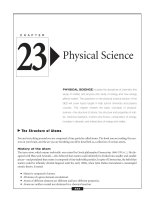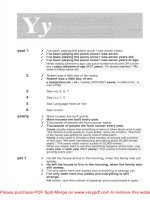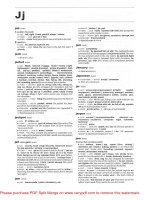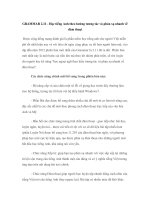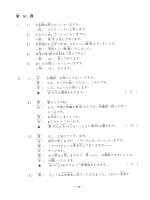2.11 How sound travels (physical science)
Bạn đang xem bản rút gọn của tài liệu. Xem và tải ngay bản đầy đủ của tài liệu tại đây (4.07 MB, 14 trang )
Genre
Nonfiction
Comprehension Skill
Important Details
Text Features
•
•
•
•
Captions
Labels
Table
Glossary
Science Content
Sound
Scott Foresman Science 2.11
ISBN 0-328-13801-0
ì<(sk$m)=bdiabc< +^-Ä-U-Ä-U
Vocabulary
Extended Vocabulary
loudness
pitch
vibrate
decibels
echoes
echolocation
frequency
sound waves
Picture Credits
Every effort has been made to secure permission and provide appropriate credit for photographic material.
The publisher deeply regrets any omission and pledges to correct errors called to its attention in subsequent editions.
Photo locators denoted as follows: Top (T), Center (C), Bottom (B), Left (L), Right (R), Background (Bkgd).
7 Rob Matheson/Corbis; 9 (T) ©Royalty-Free/Corbis;13 David R. Frazier Photolibrary, Inc./Alamy Images;
14 Jonathan Blair/Corbis; 19 Oliver Benn/Getty Images; 23 Bill Ross/Corbis.
Scott Foresman/Dorling Kindersley would also like to thank: 11 (CA) Dennoyer-Geppert Intl/DK Images.
Unless otherwise acknowledged, all photographs are the copyright © of Dorling Kindersley, a division of Pearson.
ISBN: 0-328-13801-0
Copyright © Pearson Education, Inc. All Rights Reserved. Printed in the United States of America.
This publication is protected by Copyright, and permission should be obtained from the publisher prior to any
prohibited reproduction, storage in a retrieval system, or transmission in any form by any means, electronic,
mechanical, photocopying, recording, or likewise. For information regarding permission(s), write to
Permissions Department, Scott Foresman, 1900 East Lake Avenue, Glenview, Illinois 60025.
3 4 5 6 7 8 9 10 V010 13 12 11 10 09 08 07 06 05
What did you learn?
1. Why might you hear thunder after
you see a flash of lightning?
2. What are sound waves?
3.
Many bats use
echolocation by
to Kim
findBorland
their way
around and to catch moths in the
dark. Write to explain how bats
do this. Use words from the book
as you write.
4.
Important Details In your own
words tell some important details
you’ve learned about the three
main parts of the ear and how
they work.
What You Already Know
Sounds are all around! Sound is made when
an object vibrates.
There are different ways to describe sound.
One way is by its loudness. Some sounds are soft.
Some are loud.
Another way to describe sound is by its pitch.
Objects that vibrate quickly make a sound with
a high pitch. Some birds can make high-pitched
sounds. Objects that vibrate slowly make a sound
with a low pitch. Bullfrogs can make low-pitched
sounds.
Sound moves through solids, liquids, and
gases. Sound travels fast through gases. Sound
travels even faster through liquids. Sound travels
fastest through solids.
Animals use their bodies to make sounds.
A cricket rubs its wings together. A rattlesnake
shakes the rattle in its tail. A lobster rubs its
antenna along the side of its head.
Now that you
know what sound is
and how it is made,
read on to find out
more about how
sound travels.
bullfrog
2
3
Sound Waves
If you touch a
vibrating tuning fork
to water, the sound
waves will make
the water move.
Every sound you hear is caused
by very fast movements, or vibrations.
When an object vibrates, the air around
it begins to vibrate too. The vibrations
spread out like waves. They are called
sound waves. When the sound waves
reach our ears we hear the sound.
When you tap a tuning fork,
it will vibrate and make
sound waves. The sound
waves will travel to your ear.
sound waves
tuning
fork
Sound waves can travel in all directions.
Sound waves vibrate at different speeds.
Sound waves are invisible but if you
could see them, they would look a
little like small waves, or ripples.
If you drop a pebble into a bowl
of water, you can see ripples
spreading out all around.
Sound waves spread out
all around too.
ripples
Sound waves move
like water ripples.
4
5
Speed of Sound
Which do you think travels faster, sound
or light?
Have you ever watched a thunderstorm?
Did you hear the thunder? Did you see the
lightning? Which came first?
Thunder and lightning happen at the same
time but during a thunderstorm you may see
lightning before you hear the sound it makes.
You can see lightning as soon as it happens
because light travels so fast.
You don’t hear the thunder
until a few seconds later.
That’s because sound travels
more slowly than light.
Next time you are in a thunderstorm,
count the seconds between seeing the
lightning and hearing the thunder.
6
7
Sound and Matter
Sound waves can travel through a gas,
such as air. They can travel though a liquid,
such as water. Sound waves can even travel
through solids.
Sound waves travel better through liquids
and solids than through gases. The particles
of liquids and solids are close together. The
sound vibrations can jump fast from particle
to particle.
speaking into
a cup
Sound waves made by
whales travel through water.
Sound travels best through solid objects.
That’s why these children can talk using two
cups and a string. The sound waves of the
girl’s voice travel along the string and
into the second cup. This way they
reach the boy’s ear.
vibration travels
along string
Sound waves travel
through solids.
8
9
How We Hear
We hear sounds with our ears. Our ears have
three main parts: the outer ear, the middle ear,
and the inner ear.
You can see part of your outer ear. The outer
ear collects sound waves. The sound waves strike
against the eardrum. They make the eardrum
vibrate. It sends the sound waves to the
middle ear.
The Ear
outer ear
middle ear
inner ear
eardrum
ear-hole
Having two ears
helps us figure out the
direction from which
a sound is coming.
10
The middle ear has three tiny bones.
The vibrating eardrum moves these tiny bones.
The bones pass the vibrations to the inner ear.
The inner ear is filled with a liquid. The
vibrations make ripples in the liquid. Cells in
the inner ear feel the ripples and change them
into signals. These signals go to the brain.
The brain lets us hear the signals as sound.
11
Loud or Soft?
Sounds can be loud or soft. The loudness
of sound is measured in decibels (dB).
A whisper measures about 12 decibels.
A cat’s purr measures about 25 decibels.
A jet plane at takeoff measures about
150 decibels. Blue whales make the loudest
sound of any living creature. The blue
whale makes sounds that measure up to
190 decibels!
Jet planes are very
loud at takeoff.
Have you ever cupped your hand behind your
ear so you could hear better? When you do this you
catch more sound waves. Your hand traps more
waves and feeds them into your ear. The extra
waves make the eardrum vibrate more strongly.
You will hear the sound louder.
Soft to Loud Sounds
1 dB
Falling leaves are
almost silent.
12
leaves falling
25 dB
cat’s purr
60 dB
people talking
150 dB
jet plane taking off
190 dB
call of the blue whale
13
Dangerous Sounds
Very loud sounds can be dangerous.
Sounds of 120 decibels or more can be
painful. They can damage your ears.
People who work in noisy places
need to protect their
ears from loud sounds.
The sounds can harm
their hearing.
In mountain areas,
loud sounds can make
snow come crashing down
the mountain. This is
called an avalanche.
Avalanches can
be dangerous.
High or Low?
Every sound has a frequency. Frequency is the
number of vibrations in one second. High-pitched
sounds have a high frequency. Low-pitched sounds
have a low frequency.
A whistle makes a high-pitched sound. The
sound vibrations are very fast. A bullfrog makes a
low-pitched sound. The sound vibrations are slow.
Human ears can hear some frequencies well,
but very high-pitched and very low-pitched sounds
are harder to hear.
You can hear different
frequencies if you blow over
the tops of bottles filled with
different amounts of water.
This worker is using
a jackhammer.
He wears special
earmuffs to protect
his ears from the
loud sound.
14
15
Changing Pitch
There are some sounds
that human ears cannot hear
at all. Some sounds are too
high-pitched or too low-pitched.
Some animals can hear these
sounds. Dogs can hear very
high-pitched sounds. Pigeons can
hear very low-pitched sounds.
pigeon
Fast-moving sounds can change pitch.
The siren on a police car or an ambulance
changes pitch as it passes. Next time you hear
a siren listen carefully.
The sound of the siren starts out high-pitched.
Then, when it is moving away, it changes to a
lower pitch. How does this happen?
As it comes toward you, the sound waves the
siren makes are squeezed together in front of the
ambulance. They have a high frequency and
make a high-pitched sound. When the ambulance
has passed by, the opposite happens. The sound
waves stretch out behind it. They have a lower
frequency and make a low-pitched sound.
The pitch of an
ambulance’s siren
can tell you how
close it is.
Some dogs can hear sounds
that people cannot hear.
16
17
Bouncing Sound
Sound waves can bounce. As sound waves
move, they bump into different objects. When
sound waves hit soft objects, the waves are soaked
up like water soaking into a sponge. When sound
waves hit hard objects, they bounce. Sound waves
that bounce are called echoes.
You hear echoes in some places with high walls
and ceilings, such as a school gym. Sound waves
bounce off the walls and the ceiling many times.
The sound waves from
the ringing clock bounce
off the cardboard and
travel to the boy’s ears.
ringing clock
cardboard
tube
18
Some places, such as theaters and concert
halls, are built in special ways. People want the
sound waves to travel and reach everyone in the
room, but too many bouncing echoes would ruin
a performance or music concert.
People build theaters and concert halls so
they have special shapes. They use special
materials to cover the walls, ceilings, and floors.
All this is done to make sure the sound waves
travel just right.
19
Using Echoes
Some animals use echoes to find their way
around and to hunt for food. Most bats sleep
during the day and hunt for food at night. They fly
around in total darkness. They cannot see where
they are going.
As they fly, some bats make short, high-pitched
sounds. The waves bounce off objects all around
them. The echoes tell the bats where the objects
are. This is called echolocation. Echolocation
keeps bats from crashing into things.
Bats use echolocation
to hunt.
20
How Bats Use Echoes
bat
moth
Bouncing sound waves
help bats locate objects.
Bats also use echolocation to hunt. When a bat
sends out a high-pitched sound, the sound waves
may reach a moth. The sound waves bounce, or
echo, off the moth. They return to the bat. Now
the bat knows where the moth is and can catch it.
Scientists use a kind of echolocation, called
sonar, to locate objects under the water. Scientists
bounce sound waves off the ocean floor so they
can tell how deep the water is. Sonar can help
scientists find schools of fish and sunken ships.
21
Sounds Good!
We live in a world full of sounds! Some are
soft, and some are loud. Some are high-pitched,
and some are low-pitched.
Almost everything you do makes a sound.
The next time you shake a box of cereal, listen
to the sounds. The next time you shout to a
friend across the playground, listen to the
sounds. The next time you watch fireworks,
listen to the sounds. When you turn the last
page of this book, listen to the sounds.
How many different sounds do you think you
hear in just one day? You’d probably be amazed
to know!
What kinds of sounds
do fireworks make?
22
23
Vocabulary
Glossary
loudness
pitch
decibels
vibrate
echoes
Extended Vocabulary
decibels
echoes
units used
to measure
echolocation
the loudness of sound
frequency
sound
wavesoff
sound waves
bouncing
solid objects
What did you learn?
1. Why might you hear thunder after
you see a flash of lightning?
2. What are sound waves?
3.
Many bats use
echolocation to find their way
around and to catch moths in the
dark. Write to explain how bats
do this. Use words from the book
as you write.
4.
Important Details In your own
words tell some important details
you’ve learned about the three
main parts of the ear and how
they work.
echolocation using bouncing sound waves
to locate objects
frequency
the number of sound waves
per second
sound waves vibrations made by sound
Picture Credits
Every effort has been made to secure permission and provide appropriate credit for photographic material.
The publisher deeply regrets any omission and pledges to correct errors called to its attention in subsequent editions.
Photo locators denoted as follows: Top (T), Center (C), Bottom (B), Left (L), Right (R), Background (Bkgd).
7 Rob Matheson/Corbis; 9 (T) ©Royalty-Free/Corbis;13 David R. Frazier Photolibrary, Inc./Alamy Images;
14 Jonathan Blair/Corbis; 19 Oliver Benn/Getty Images; 23 Bill Ross/Corbis.
Scott Foresman/Dorling Kindersley would also like to thank: 11 (CA) Dennoyer-Geppert Intl/DK Images.
Unless otherwise acknowledged, all photographs are the copyright © of Dorling Kindersley, a division of Pearson.
ISBN: 0-328-13801-0
Copyright © Pearson Education, Inc. All Rights Reserved. Printed in the United States of America.
This publication is protected by Copyright, and permission should be obtained from the publisher prior to any
prohibited reproduction, storage in a retrieval system, or transmission in any form by any means, electronic,
mechanical, photocopying, recording, or likewise. For information regarding permission(s), write to
Permissions Department, Scott Foresman, 1900 East Lake Avenue, Glenview, Illinois 60025.
24
3 4 5 6 7 8 9 10 V010 13 12 11 10 09 08 07 06 05
